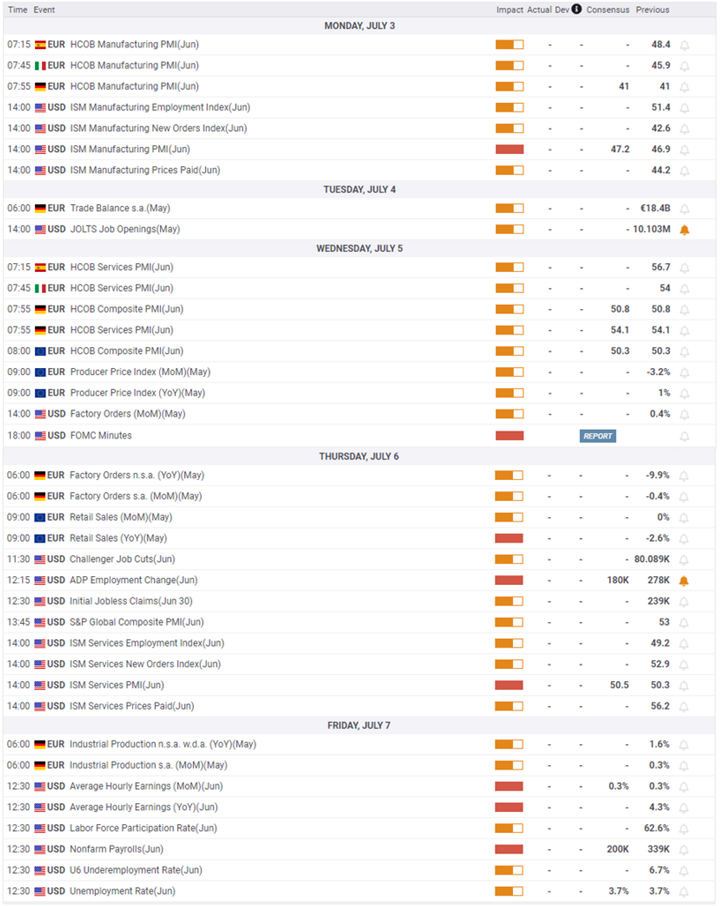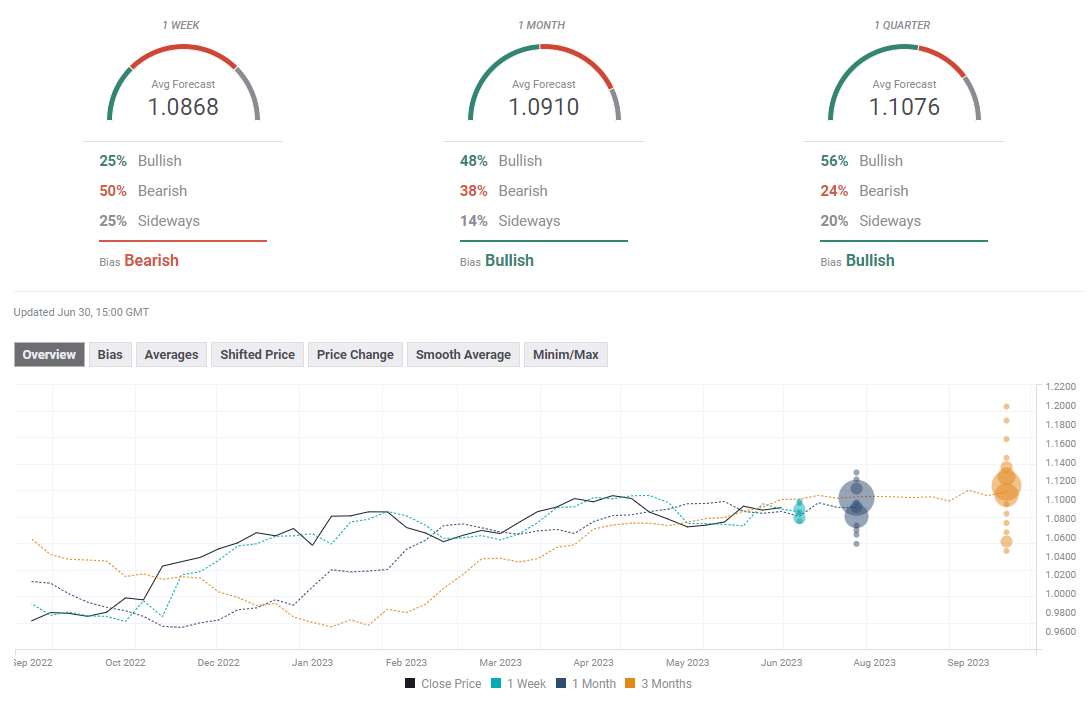- The US Dollar shows resilience despite risk appetite, supported by robust US economic data.
- The Euro performs mixed as hawkish ECB support fades.
- The pair continues to trade in a familiar range, with the main trend being up.
The EUR/USD posted its second consecutive weekly decline, extending its retreat after testing 1.1000 but managed to hold above 1.0900. The pair continues to trade within a familiar range, with a stronger US dollar keeping the upside limited, while positive risk sentiment and hawkish expectations about the outlook of the European Central Bank (ECB) are helping to limit the losses.
Dollar gains support on the back of US data
On Tuesday, the EUR/USD peaked at 1.0977 and then reversed its direction, following the ECB Sintra Forum and amid a stronger US dollar. The pair bottomed at 1.0835 on Thursday, the lowest level in two weeks. After the release of the US Core Personal Consumption Expenditure data on Friday, the pair moved higher, recovering above 1.0900 as the US Dollar pulled back.
The US Dollar was the top performer among majors during the week. The key driver has been US economic data and Federal Reserve Chair Jerome Powell’s repeated message. Powell did not surprise the market; he reiterated that FOMC members still see more interest rate hikes before year-end. Weeks ago, that outlook differed significantly from market expectations, which by July were speculating with a peak and pointing to several rate cuts before year-end.
The recession forecast by economists did not arrive and, on the contrary, the latest round of economic data from the US has been robust, adding more conviction to the Fed’s outlook and, at the same time, boosting bets of the central bank raising rates at the July meeting after June’s pause. Now the markets are starting to see the future more similarly to how the Fed sees it, which has led to higher US Treasury yields and a stronger US Dollar. Markets are beginning to price in a potential second interest rate hike.
The economic reports released this week showed that the US economy is still expanding, with GDP growing more than previously reported during the first quarter. Initial Jobless Claims improved last week. Even housing data has remained somewhat resilient despite the increases in interest rates. Overall, in terms of economic activity, no recession is seen on the horizon, and this set of data keeps the door open to more rate hikes.
The other critical indicator for the FOMC is inflation. The Core PCE on Friday came in slightly below market forecasts. The Fed’s preferred inflation measure fell from 4.7% to 4.6%, and the headline declined from 4.3% in April to 3.8% in May, below the expected 4.6%. The numbers alleviated Fed rate hike expectations and weighed on the US Dollar late on Friday. Inflation is still above the target, but the downtrend is still in place.
Euro's support from the ECB is weakening
The rhetoric from the European Central Bank (ECB) did not change and remained the same after the Sintra Forum. Lagarde and company reiterated that a rate hike in July is practically a done deal, and they don't know what will happen in September. The bias is and will remain hawkish after the July meeting, but the outcome, as policymakers keep saying, will be "data-dependent." Markets largely believe this. So far, they see another hike in September, but that could be the final one.
Important inflation data was released during the week. It showed that inflation's trend in the Eurozone remains on the downside, albeit not accelerating, and the Core rate shows "stickiness". The German inflation rate rose slightly in June from 6.1% to 6.4%, and core inflation from 5.4% to 5.8%. The Eurozone annual headline inflation rate came in at 5.5% in May, down from 6.1% in April, while core inflation rose from 5.3% to 5.4%.
All in all, inflation remains above target, particularly the core. However, the trend is down. At the same time, European PMI indicators last week showed softening signs of the Eurozone economy. The balance remains toward more monetary policy tightening, and the ECB is making that clear. The hawkishness is not supporting the Euro as it used to do.
European stocks and Wall Street traded higher during the week. The positive risk sentiment did not affect the US Dollar significantly. Markets cheered positive data that pointed to economic expansion at a slower pace and inflation trending lower, which is positive for markets. But it is not clear if it will last. The good mood in the markets helped the pair remain in the current range.
US jobs data takes center stage
Next week, economic reports from the Eurozone include the final reading of the PMIs (Monday for Manufacturing and Wednesday for Services), which should not bring any major surprises. Regarding inflation, the important number will be the Eurozone Producer Price Index (Wednesday). Eurozone Retail Sales and German Factory Orders are due on Thursday, and German Industrial Production on Friday.
Risk sentiment will continue to be important for the Euro. However, the dynamic regarding the US Dollar will also be crucial for EUR/USD. Although being a shortened week in the US, with markets closed on July 4 due to Independence Day, in terms of economic data, it will be an important week, with focus on activity and labor market numbers.
On Monday, the US ISM Manufacturing is due, and on Thursday, the Service sector. On Thursday, ADP will release its private sector employment report and the Labor Department the weekly Jobless Claims. The most important report of the week will be on Friday with the June official jobs report. Nonfarm payrolls are seen rising by 200,000, showing that the labor market remains strong. These numbers will be relevant for the US Dollar and expectations about monetary policy.
Additionally, the Fed will release the minutes of its latest meeting on Wednesday. The document will show the considerations that led to the decision to keep rates unchanged. However, Chair Powell has delivered many messages since the meeting, leaving little room for surprises. The next FOMC meeting is on July 25-26. The odds of a rate hike are elevated, and the economic figures next week could change those expectations.
EUR/USD technical outlook
The EUR/USD continues to move in a familiar range without a clear direction. The recent readings on the weekly chart are mixed, showing no strong conviction. The pair remains above the 20-week Simple Moving Average (SMA) and also above a short-term uptrend line. The risks are still tilted to the upside, but the pair needs a weekly close above 1.1000 to unleash bullish potential. On the contrary, a close under the 20-SMA at 1.0810 would suggest more weakness ahead, exposing the 1.0700/20 area.
The comfort zone around 1.0900 prevails in the short term and could continue to be the case over the next sessions, considering that low volume may be expected amid the US holiday. However, volatility could jump later, boosted by economic reports. Such moves could challenge key levels in EUR/USD. On the upside, the first area is 1.0960/70, with a break above exposing 1.1000. Above that level, the critical resistance continues to be the 1.1100 mark.
On the daily chart, the rebound of the Euro was critical on Friday. It avoided a close under the 20-day SMA at 1.0860 that would have suggested a deeper correction ahead, toward 1.0780. Momentum on the daily chart is above its midline, but other indicators like the Relative Strength Index (RSI) have flattened, showing no clear bias.
EUR/USD sentiment poll
The FXStreet Forecast Poll shows that market players expect the EUR/USD to advance over the next few months. In the short term, they have a neutral perspective, with the average forecast around the current level. On a quarterly perspective, they see the pair moving above 1.1000, with an average forecast of 1.1076. However, many experts see the EUR/USD rising above 1.1400.
Information on these pages contains forward-looking statements that involve risks and uncertainties. Markets and instruments profiled on this page are for informational purposes only and should not in any way come across as a recommendation to buy or sell in these assets. You should do your own thorough research before making any investment decisions. FXStreet does not in any way guarantee that this information is free from mistakes, errors, or material misstatements. It also does not guarantee that this information is of a timely nature. Investing in Open Markets involves a great deal of risk, including the loss of all or a portion of your investment, as well as emotional distress. All risks, losses and costs associated with investing, including total loss of principal, are your responsibility. The views and opinions expressed in this article are those of the authors and do not necessarily reflect the official policy or position of FXStreet nor its advertisers. The author will not be held responsible for information that is found at the end of links posted on this page.
If not otherwise explicitly mentioned in the body of the article, at the time of writing, the author has no position in any stock mentioned in this article and no business relationship with any company mentioned. The author has not received compensation for writing this article, other than from FXStreet.
FXStreet and the author do not provide personalized recommendations. The author makes no representations as to the accuracy, completeness, or suitability of this information. FXStreet and the author will not be liable for any errors, omissions or any losses, injuries or damages arising from this information and its display or use. Errors and omissions excepted.
The author and FXStreet are not registered investment advisors and nothing in this article is intended to be investment advice.
Recommended Content
Editors’ Picks

EUR/USD extends slide below 1.0300, touches new two-year low
EUR/USD stays under bearish pressure and trades at its lowest level since November 2022, below 1.0300 on Thursday. The US Dollar benefits from the risk-averse market atmosphere and the upbeat Jobless Claims data, causing the pair to stretch lower.

GBP/USD slumps to multi-month lows below 1.2400 on broad USD strength
Following an earlier recovery attempt, GBP/USD reversed its direction and declined to its weakest level in nearly eight months below 1.2400. The renewed US Dollar (USD) strength on worsening risk mood weighs on the pair as trading conditions normalize after the New Year break.

Gold benefits from risk aversion, climbs above $2,650
Gold gathers recovery momentum and trades at a two-week-high above $2,650 in the American session on Thursday. The precious metal benefits from the sour market mood and the pullback seen in the US Treasury bond yields.

These 5 altcoins are rallying ahead of $16 billion FTX creditor payout
FTX begins creditor payouts on January 3, in agreement with BitGo and Kraken, per an official announcement. Bonk, Fantom, Jupiter, Raydium and Solana are rallying on Thursday, before FTX repayment begins.

Three Fundamentals: Year-end flows, Jobless Claims and ISM Manufacturing PMI stand out Premium
Money managers may adjust their portfolios ahead of the year-end. Weekly US Jobless Claims serve as the first meaningful release in 2025. The ISM Manufacturing PMI provides an initial indication ahead of Nonfarm Payrolls.

Best Forex Brokers with Low Spreads
VERIFIED Low spreads are crucial for reducing trading costs. Explore top Forex brokers offering competitive spreads and high leverage. Compare options for EUR/USD, GBP/USD, USD/JPY, and Gold.

-638237363144081973.png)
